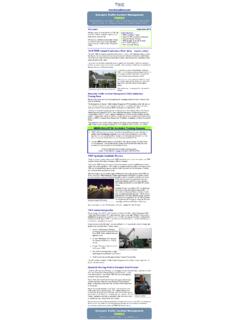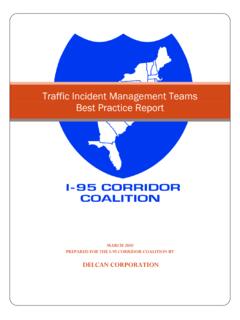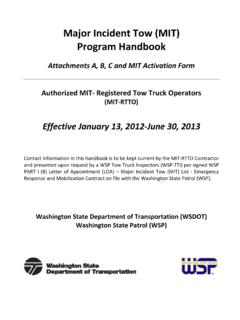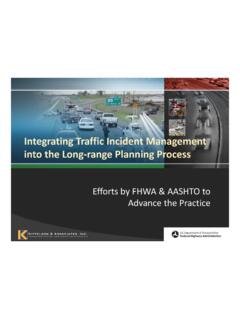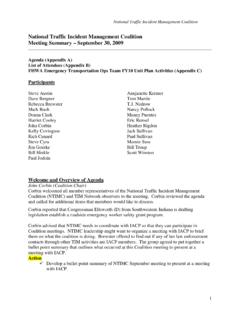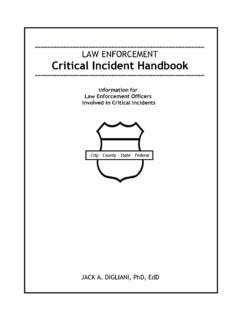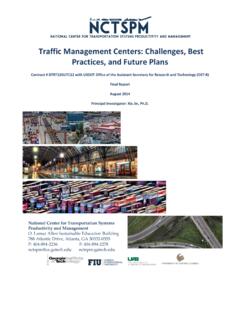Transcription of Traffic Incident Management Handbook - Volume 4
1 Traffic Incident Management Handbook Prepared for: Federal Highway Administration Office of Travel Management Prepared by: PB Farradyne November 2000 Traffic Incident Management Handbook i Table of Contents 1 INTRODUCTION TO Incident THE Safety Implications of Incident Incident Management Motorist Site Traffic ROLES AND Law Fire and Emergency Medical Services (EMS)..1-11 Transportation Towing and Recovery Service Information Service Providers (ISPs)..1-14 Coroners and Medical Hazardous IDENTIFYING OPPORTUNITIES FOR Review Goals and Evaluate Current Establish Assess Training 2 ORGANIZING, PLANNING, AND DESIGNING AN Incident Management STEPS IN DEVELOPING AN Incident Management Prologue to the Process: Getting the Players to the THE BASIC 8-STEP Incident Management PROGRAM DEVELOPMENT PROCESS2-4 Define the Set Goals and Develop Evaluate Select Implement Reevaluate Refine the ELEMENTS OF SUCCESSFUL Incident Management Elements of Successful Incident Management Programs: Traffic Incident Management Handbook ii Elements of Successful Incident Management Programs.
2 Infrastructure and Operational Elements of Successful Incident Management Incident Management PROGRAM Quantitative Qualitative 3 OPERATIONAL AND TECHNICAL APPROACHES TO IMPROVING THE Incident Management Intelligent Transportation System (ITS)..3-1 MOTORIST SITE Traffic Preparing for Effective Traffic Improve Traffic Flow Past the Improve Traffic Flow on Alternate On Site Clearance Clearance Towing Company Wrecker Service Removal of Truck Accident Ordinances Relating To Incident APPENDIX A APPENDIX B EXAMPLE MEMORANDA OF APPENDIX C MODEL TOWING Traffic Incident Management Handbook iii List of Figures Figure 1-1: Fixed tow-trucks using multiple lanes to upright Figure 1-2: Congestion from even minor incidents can be Figure 1-3: Disabled vehicle being attended to by DOT service Figure 1-4: Composit Profile of Reported Incident by Figure 1-5.
3 Infrastrucutre damage can occur that requires timely Figure 1-6: Crash victim being airlifted from Incident Figure 1-7: DOT operated air-bag being used to up-right tractor-trailer 1-12 Figure 1-8: Crashes involving tractor-trailers can cause significant infrastrucutre Figure 2-1: Tractor-trailer accidents can signifcantly impact the flow of Figure 2-2: Goals and objectives may be developed for each function of Incident Figure 2-3: Agencies have identified several innovative ways to finance service patrols2-10 Figure 2-4: Procuring equipment for Incident clearance may be one alternative that may be evaluated to improve the Incident Management Figure 2-5: Service patrol technician asisting Figure 3-1: CCTV Figure 3-2: TOC operators obseving monitor Figure 3-3: HAR station with warning Figure 3-4: In-vehicle navigational Figure 3-5: Incident site involving multiple Figure 3-6: Incident responders coordinating Figure 3-7: Response vehicles staged at the Incident Figure 3-8: Unified command has fostered coordination and cooperation for many Figure 3-9: Traffic Management at the Incident Figure 3-10: Alternate route Figure 3-11: Long-term operaion of an alternate Figure 3-12: Clearance of a tractor-triler Figure 3-13: Service patrol assisting stalled Figure 3-14: Private service provider removing over-turned Traffic Incident Management Handbook iv List of Tables Table 1-1: Percentage of freeway capacity available under Incident Table 2-1.
4 Data useful in identifying Incident Management issues and Table 2-2: Identifying goals and Table 2-3: Common Incident Management program goals and Table 2-4: WSDOT Incident response database Traffic Incident Management Handbook 1-1 1 Introduction to Incident Management PURPOSE Incident Management is defined as the systematic, planned, and coordinated use of human, institutional, mechanical, and technical resources to reduce the duration and impact of incidents, and improve the safety of motorists, crash victims, and Incident responders. These resources are also used to increase the operating efficiency, safety, and mobility of the highway by systematically reducing the time to detect and verify an Incident occurrence; implementing the appropriate response; and safely clearing the Incident , while managing the affected flow until full capacity is restored.
5 This Handbook will assist agencies responsible for Incident Management activities on public roadways to improve their programs and operations. Agencies typically responding to highway incidents include: Police Fire 911 dispatch Towing and recovery Emergency medical service (EMS) Hazardous material Transportation agencies Media The intended audience for this Traffic Incident Management Handbook is primarily (1) managers who are responsible for Incident Management program development; and (2) field practitioners who are responsible for providing program services on a day-to-day basis. As such, this Handbook provides guidance from two perspectives: First, as a process to follow in establishing a new Incident Management program or in improving an existing one, and second, through the identification of tools and strategies that can enhance field operations.
6 This document is an update to the Freeway Incident Management Handbook , published in 1991 by the FHWA. It provides detail on important elements of successful Incident Management programs, as well as field operations. It includes new and advanced Incident Management topics. This update assumes that the Traffic congestion issues posed by incidents are already well understood by most agency personnel. As such, the focus in this update is on the safety benefits achievable through effective Incident Management , as experienced by crash victims, the motoring public, and response agency field personnel. As implied in this Handbook s title, this update promotes the notion that Incident Management is needed on all types of highways, not just freeways.
7 ORGANIZATION Traffic Incident Management Handbook 1-2 Figure 1-1: Fixed tow-trucks using multiple lanes to upright tractor-trailer This Handbook is organized into three major sections: Introduction to Incident Management Organizing, planning, designing and implementing an Incident Management program Operational and technical approaches to improving the Incident Management process THE PROBLEM An Incident is defined as any non-recurring event that causes a reduction of roadway capacity or an abnormal increase in demand. Such events include Traffic crashes, disabled vehicles, spilled cargo, highway maintenance and reconstruction projects, and special non-emergency events ( , ball games, concerts, or any other event that significantly affects roadway operations).
8 Although the problems most often associated with highway incidents is traveler delay, by far the most serious problem is the risk of secondary crashes. Another related issue is the danger posed by incidents to response personnel serving the public at the scene. Other secondary effects of incidents include: Increased response time by police, fire, and emergency medical services Lost time and a reduction in productivity Increased cost of goods and services Traffic Incident Management Handbook 1-3 Increased fuel consumption Reduced air quality and other adverse environmental impacts Increased vehicle maintenance costs Reduced quality of life Negative public image of public agencies involved in Incident Management activities. The magnitude of these problems is severe. Incidents critically limit the operational efficiency of the transportation network and put all users of the network at risk.
9 However, the impacts can be mitigated. Safety Implications of Incidents A Minnesota study found that 13 percent of all peak period crashes were the direct result of a previous Incident (1). A study by the Washington State Department of Transportation further emphasizes this point. The study found that, over a seven-year period, 3,165 shoulder collisions had occurred on interstate, limited access, or other state highways. These collisions caused 40 deaths and 1,774 injuries. Injury rates for shoulder collisions were substantially higher than the rates for all other accident categories. The study noted that 41 percent of all shoulder collisions involved injuries (2). In addition, the severity of secondary crashes is often greater than that of the original Incident .
10 The longer an Incident is in place, the greater the exposure to additional crashes. A 1995 analysis of collision statistics on several arterials and expressways in California showed that secondary crashes represent an increase in collision risk of over 600 percent (3). Incident responders are at risk of being struck by passing vehicles as they are performing their duties. In 1997, nearly 40 percent of all law enforcement officers who died in the line of duty died in Traffic (4). The longer an Incident is in place, the longer Incident responders are vulnerable and exposed to injury. In addition to the hazards of the Incident scene, emergency responders traveling to other emergencies or emergency medical vehicles transporting sick or injured to medical facilities are also at risk because of incidents.

